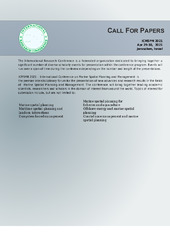Приказ основних података о документу
Sustainable Approach in Spatial Planning of River Corridors as an Instrument of Integration and Support in Development of Marine Areas: Case-study of Danube Pan-European Water Corridor in Serbia.
| dc.creator | Stefanović, Nebojša | |
| dc.creator | Milijić, Saša | |
| dc.creator | Danilović Hristić, Nataša | |
| dc.date.accessioned | 2023-03-07T09:13:24Z | |
| dc.date.available | 2023-03-07T09:13:24Z | |
| dc.date.issued | 2021 | |
| dc.identifier.uri | http://raumplan.iaus.ac.rs/handle/123456789/769 | |
| dc.description.abstract | The Danube River is the most important and the second largest river in Europe, representing the Pan-European water corridor (VII) and system which links North sea with Black sea and Mediterranean sea. Danube River is navigable through Serbia in all its length of 588 km, and represents the most attractive part of the river in Europe for navigation. This paper starts from hypothesis that sustainable development of river corridors can be integral part and support for the development of river and marine areas. The purpose of this paper is to identify key tourist resources, navigable, ecological, cultural and historical in the first place, which would be used as a basis for the analysis of the river coridor and its role in the development and integration with marine regions. This paper analyzing Spatial plan for the special purpose area of the international waterway corridor E-80 Danube in Serbia and strategic importance of spatial–functional organization of Danube River corridor. This paper starts from the location of key tourism resources, primarily water areas, natural and cultural heritage of the coast. Based on the identified tourist resources and analyzed the planning basis, the paper proposes a differentiation of the Danube on highly valuable tourist area, which differ and interconnected. Starting with the priorities of sustainable development of tourism in the Danube region, authors proposed criteria for the selection of locations nautical points and criteria for differentiation of settlements and localities in the Danube River, according to the importance for the development of nautical tourism and nautical infrastructure. The authors especially emphasize that recreate cruise is base activity of nautical tourism, done in different boats and conditions, that ask for special infrastructural objects in function of type of aqua areas. From the aspect of sustainable tourism development, paper analyzes the opportunities for sustainable development and multimodal transport tourists in this corridor. In addition, the authors point out the importance and possibilities of uniting the tourist offer on the Danube with the tourist offer of the coastal sea zones, especially on the Black Sea, emphasizing the importance of nautical tourism in that. Special attention was paid to the guidelines for the development of nautical and other navigable infrastructure. The paper suggests that the priority should be to have a nautical infrastructure development, increase the availability and presentation of tourist resources, integration and diversification of the tourist offer on the Danube River and its marine surroundings. | sr |
| dc.language.iso | en | sr |
| dc.publisher | WASET - World Academy of Science, Engineering and Technolog | sr |
| dc.relation | info:eu-repo/grantAgreement/MESTD/inst-2020/200006/RS// | sr |
| dc.rights | openAccess | sr |
| dc.source | ICMSPM 2021: 15. International Conference on Marine Spatial Planning and Management, April 29th-30th, 2021, Jerusalem, Israel | sr |
| dc.subject | Danube | sr |
| dc.subject | development | sr |
| dc.subject | nautical infrastructure | sr |
| dc.subject | Pan-European water corridor | sr |
| dc.subject | spatial plan | sr |
| dc.subject | spatial planning | sr |
| dc.subject | river corridor | sr |
| dc.subject | tourism | sr |
| dc.title | Sustainable Approach in Spatial Planning of River Corridors as an Instrument of Integration and Support in Development of Marine Areas: Case-study of Danube Pan-European Water Corridor in Serbia. | sr |
| dc.type | conferenceObject | sr |
| dc.rights.license | ARR | sr |
| dc.citation.rank | M32 | |
| dc.identifier.fulltext | http://raumplan.iaus.ac.rs/bitstream/id/3222/ICMSPM_2021_NS_SM_NDH.pdf | |
| dc.identifier.rcub | https://hdl.handle.net/21.15107/rcub_raumplan_769 | |
| dc.type.version | publishedVersion | sr |

